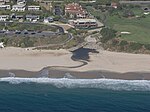Hangover House

Hangover House (also known as the Halliburton House) was designed and built by William Alexander Levy for his friend the travel writer Richard Halliburton. Halliburton had first spotted the ridgetop site while riding on horseback on the beach in 1930. In 1937, Halliburton stated he had purchased a house in Laguna Beach, California. Constructed in 1938 on a hilltop, the house, boasting commanding views of the Pacific Ocean and Aliso Canyon, was built with three bedrooms, one each for Halliburton, Alexander, and Halliburton's secretary and friend Paul Mooney, who was also the explorer's editor and ghostwriter. Halliburton reportedly spent US$42,000 (equivalent to $870,000 in 2022) on the purchase of the site and construction of the house.
Excerpt from the Wikipedia article Hangover House (License: CC BY-SA 3.0, Authors, Images).Hangover House
Ceanothus Drive,
Geographical coordinates (GPS) Address Nearby Places Show on map
Geographical coordinates (GPS)
| Latitude | Longitude |
|---|---|
| N 33.509632 ° | E -117.747628 ° |
Address
Ceanothus Drive 31222
92651
California, United States
Open on Google Maps








